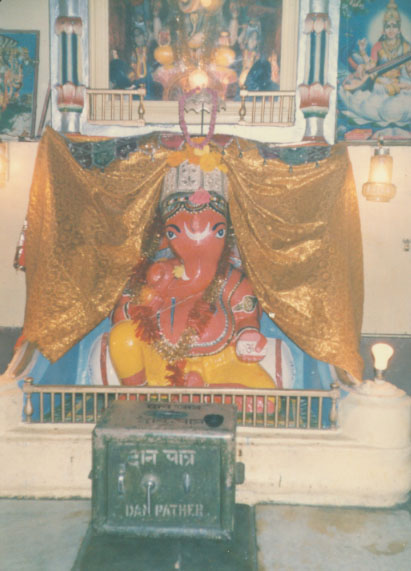|






|
 |
|
 |
 |
 |
 |
Hinduism in Kashmir
The
religious practices of Hindus of Kashmir
(popularly known as Kashmiri Pandits) revolve
around the worship of Shiva and Shakti. All other
deities
(gods and goddesses) of the traditional
Hindu pantheon are worshipped as various
manifestations of Shiva and Shakti. Shiva is the
Supreme Lord of the universe and Shakti, the
Universal Mother Goddess, is his eternal
companion. Bhairavas and Ganas are also his divine
companions and they are also worshipped with him
on important festivals, such as Shivaratri. There
are numerous Shiva shrines in Kashmir, such as
Amareshvara, Vijayeshvara, Sureshvara,
Harsheshvara, Mahaadeva, Bhuteshvara,
Haramukheshvara. The shrines dedicated to Shakti
are Tripurasundari, Trisandhyaa, Jvaalaamukhi,
Shailaputri, Shaarikaa, Shaarada, Rajni, and
Khirbhavaani.
Pandits) revolve
around the worship of Shiva and Shakti. All other
deities
(gods and goddesses) of the traditional
Hindu pantheon are worshipped as various
manifestations of Shiva and Shakti. Shiva is the
Supreme Lord of the universe and Shakti, the
Universal Mother Goddess, is his eternal
companion. Bhairavas and Ganas are also his divine
companions and they are also worshipped with him
on important festivals, such as Shivaratri. There
are numerous Shiva shrines in Kashmir, such as
Amareshvara, Vijayeshvara, Sureshvara,
Harsheshvara, Mahaadeva, Bhuteshvara,
Haramukheshvara. The shrines dedicated to Shakti
are Tripurasundari, Trisandhyaa, Jvaalaamukhi,
Shailaputri, Shaarikaa, Shaarada, Rajni, and
Khirbhavaani.
The religious philosophy
of Kashmiri Hindus is rooted in Kashmiri Shaivism,
a school of Shiva philosophy that originated near
Kailasha in Himalayas around 400 AD. The first
teacher of this school was Tryambakaditya, a
disciple of sage Durvasas. Sangamaditya, the
sixteenth descendent in the line of Tryambakaditya,
later settled in Kashmir valley around 800 AD. His
fourth descendent, Somananda, extracted the
principles of monistic Shiva philosophy from the
scriptures and incorporated them in his own work,
Shivadrishti, which is the first philosophical
treatise on Kashmiri Shaivism. Later a galaxy of
illumined sages, such as Vasugupta, Kallata,
Utapaladeva, and Abinavagupta further refined this
philosophy. The philosophy of Kashmiri Shaivism is
generally called Trika Shastra, since it is a
philosophy of the Triad: Shiva, Shakti, and Nara
(the bound individual self). The literature of the
Trika System of Kashmir comprises of three
categories: the Agama Shastra, the Spanda Shastra,
and the Pratyabhijna Shastra.
Kashmiri Shaivism, also
known as Pratyabhijna (meaning
"recognition") school of Shaivism,
adopts a purely monistic metaphysical position. It
considers the Supreme Lord, called Shiva or
Maheshvara, as the Supreme Reality, which is
innermost as well as transcendent. As a conscious
and active principle, the individual self (atman)
is identical with the Supreme Lord. Due to the
influence of maya (ignorance) the individual self
forgets its divine nature, becomes liable to
limitation and bondage, and thinks itself to be
different from the Supreme Lord. Thus one's mukti
(spiritual freedom) lies in one's clear
recognition (Pratyabhijna) of one's identity with
the Supreme Lord. In Kashmiri Shaivism we find a
type of religious thought which synthesizes
pluralism, dualism, and the Buddhist doctrine of
Shunya, and develops a nondualist philosophy which
is sweet, sublime and constructive. This
philosophy is closer to the theism of the Bhagvad
Gita than to the nihilism of Buddha.
Kashmiri Shaivism is free
from restrictions of caste, creed, and gender. Any
devout aspirant can have access to both the theory
and practice of this philosophy. In Kashmiri
Shaivism, practice of religion is considered more
important than theological debates and
discussions. Kashmiri Shaivism does not advocate a
life of renunciation (Sannyasahood) or profession
of monks, but recommends an active householder's
life with daily practice of worship, yoga and
meditation. The use of outward symbols, such as
yellow and orange robes, matted hair, and ashes
are prohibited. Worldly enjoyment as a goal of
worldly life is recognized and respected, but a
spiritual path aimed at harmonizing bhukti
(worldly enjoyment) and mukti (liberation) is
advocated. Kashmiri Shaivism does not advocate
suppression of one's emotions and instincts, but
provides a spiritual path aimed at their
sublimation towards the ultimate goal of spiritual
freedom.

- Bansi Pandit
 Hindu
Dharma Hindu
Dharma
Hindu
Dharma explains the symbolism of
the Hindu deities and includes
nine beautiful color pictures of
the popular Hindu deities. These
pictures can be used for daily
puja (worship) in the home shrines
by the devotees. The book also
includes the historic address of
Swami Vivekananda on Hinduism at
the 1893 World Parliament of
Religions in Chicago.
>>>
|
|
 Hindu
Deities Hindu
Deities
Just
as a single force in space can
be mathematically conceived as
having various spatial
components, the Supreme Being or
God, the personal form of the
Ultimate Reality, is conceived
by Hindus as having various
aspects. A Hindu deity (god or
goddess; note small g)
represents a particular aspect
of the Supreme Being.
>>>
|
|
|
|
 Places
of Worship Places
of Worship
The
valley being sacred and called
Rishi wari till now, abounds
in sacred places, Tirthas and
Asthans. Long ago at the dawn
of civilisation when the sons
of Rishi Kashyapa from plains
came to settle here they
brought with them their
traditions, religion,
mythology etc. >>>
|
|
 Ancient
and Modern Ascetics in Kashmir Ancient
and Modern Ascetics in Kashmir
These
saints belong to all times
and to all nations. They
transcend the bonds of
communities and conventions,
place and time. They are
born to serve God by serving
His creatures. A saint, a
seer and a sage is, indeed
an universal phenomenon.
>>>
|
|
|
|
 Rituals
and Ceremonies Rituals
and Ceremonies
The
ritual culture of
the people of
Kashmir grew from
its Burzahom past
and is, therefore,
formed of several
sediments; the
basic sediments
have their origin
in the ritual
structure of the
Burzahom people
and the people of
Kashmir who lived
through the
Neelmat period.
>>>
|
|
 A
Kashmiri Pandit Marriage A
Kashmiri Pandit Marriage
Kashmiris
first match the teknis
(horoscopes) of the
prospective bride and
groom. Besides this, the
other factors which are
taken into consideration
while selecting a match
are the background, status
and moral character of the
family of the prospective
match and their close
relatives. >>>
|
|
|
|
 Lal
Ded's Vakhs Lal
Ded's Vakhs
Kashmir
has
produced
many
saints,
poets and
mystics.
Among
them, Lal
Ded is
very
prominent.
In
Kashmir,
some
people
consider
her a
poet, some
consider
her a
holywoman
and some
consider
her a sufi,
a yogi, or
a devotee
of Shiva.
>>>
|
|
 Kashmiri
Hindus
and the
Caste
System Kashmiri
Hindus
and the
Caste
System
It
is
generally
accepted
that all
the
Kashmiri
Hindus
belong
to the
same
community
or jati.
Is that
because
they
belong
to a
single
caste or
varna
resulting
from the
conversion
of the
other
castes
to
Islam?
>>>
|
|
|
|
 Nilmata
Purana Nilmata
Purana
The
Nilamata
says
that
the
land
of
Kasmira
was
thronged
with
ever-sportive
and
joyful
people
enjoying
continuous
festivities.
Living
amidst
scenes
of
sylvan
beauty
they
played,
danced
and
sang
to
express
their
joys,
to
mitigate
their
pains,
to
please
their
gods
and
to
appease
their
demons.
>>>
|
|
 Kashmir
Shaivism Kashmir
Shaivism
Shaivism
of
Kashmir
has
developed
between
the
eight
and
the
twelfth
centuries
of
the
Christian
era.
This
comparatively
younger
philosophy
has
tried
to
explain
all
such
ambiguities
which
the
ancient
philosophers
have
failed
to
resolve.
>>>
|
|
|
|
 Kundalini
-
Articles
by
Gopi
Krishna Kundalini
-
Articles
by
Gopi
Krishna
Kundalini
is
the
guardian
of
human
evolution
and
the
key
to
the
mystery
of
existence.
There
is
nothing
in
the
whole
mass
of
knowledge,
gathered
by
mankind
so
far,
of
such
paramount
importance
as
this.
>>>
|
|
 Ganesh
Astuti Ganesh
Astuti
He
who
is
son
of
the
daughter
of
the
kingdom
of
mountains
Parvati,
He
who
is
leader
of
the
multitude
of
Gods,
He
who
is
dear
to
Shiva,
He
who
has
one
tusk,
He
who
has
a
curved
trunk,
He
who
has
snake
around
his
neck
as
yagnopavit. >>>
|
|
|
|
 Henzae:
A
Folk
Genre
Viewed
Afresh Henzae:
A
Folk
Genre
Viewed
Afresh
HENZAE
seems
to
be
the
oldest
extant
folk
genre
of
Kashmiri
verse.
Alongside
the
proverb
and
the
riddle
it
certainly
is
one
of
the
earliest
items
of
folklore
in
the
Kashmiri
language.
It
signifies
a
conventional
type
of
the
ceremony
chant
called
vanavun. >>>
|
|
 Devotional
Songs Devotional
Songs
|
| |
 |
 |
 |
 |
|
|

